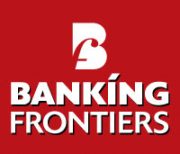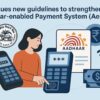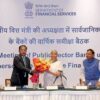A stream of digital initiatives is transforming Mutual Trust Bank and its customer engagement, reveals Khalid Hossin, who heads the bank’s digital banking division:

Smriti Pandey: Since when are you a Chief Digital Officer?
Khalid Hossin: Since 2021, I have been the Head of Digital Banking Division (HoDBD), Mutual Trust Bank.
Briefly describe your first major project as CDO?
My first major project as Head of Digital Banking Division was establishing Open Banking Ecosystem, so that MTB can offer BaaS (Banking as a Service). The main challenge was that our core banking solution’s (CBS) requirements had been finalized much earlier without the vision of Open Banking, and also CBS at that time lacked the vision for Open Banking, and so hardly any APIs were available. So, later, when I took over as HoDBD, I had to lead the initiative to transform the existing CBS to an Open Banking-enabler CBS by creating proper API requirements, and ensuring proper API availability and usability. This transformed MTB, as now, we are the most connected bank in Bangladesh having over 35 co-created Open Banking powered digital business products by partnering with 35 fintechs, tech-fins, agri-techs, start-ups, telcos, MFs, aggregators and marketplaces.
Briefly describe one experimental/innovative project that you have recently completed or are in the process of completing, that is associated with a new technology or new financial products. What is its expected impact?
One experimental innovative project I am nearly finishing up is ‘MTB Daylight Loan’. This is a unique digital lending product, where the customer will avail the loan on or before daybreak, and will repay the loan before dusk or evening each day, hence the name Daylight Loan. This is targeted towards the kitchen market vendors like vegetable, fish, fruit sellers, marginal entrepreneurs who need small capital daily to procure goods/raw materials to sell their products. During onboarding, a customer profile is created on the basis of available data and a digital underwriting model developed by MTB. After that, customer can use app and any ATM to withdraw cash as per his/her profile. Customer can use any CRM to return loan amount plus fee. We have already completed the pilot in a kitchen market area for this, and the results have been phenomenal. The pilot customers have made terrific use of this fund to upscale their business. Also, loan repayment was extremely good, with less than 0.2% failed repayment rate. I am in the process of officially going live with this initiative and I believe this has tremendous potential in countries like Bangladesh, India, Nepal, Sri Lanka, etc.
While digital transformation engages the digital natives effortlessly, is there any project that you have worked on that has made a significant impact on the digital non-natives? If yes, please describe the project and its impact.
I have launched an initiative called ‘Cash by Code’, by using which, any person, regardless of having a bank account or not, without having any relationship with bank, can withdraw cash using code. This means that a digital non-native can simply walk up to any MTB ATM, select cash by code, input code (which is available in beneficiary SMS), input OTP (which is available in beneficiary SMS), and can withdraw cash. To avail this service, one doesn’t need a smartphone. This is very useful for digital non-natives, especially those who rely on button-based feature phones.
Another project I have worked on is zero balance prepaid card, where the card mirrors the MFS wallet balance of the user. This enables the user to use the card for various banking activities like payments, cash withdrawals, etc. The main use case is for the RMG workers / marginalized workers who get their salary in MFS, earlier had to rely on MFS agent to cash out. But now, they can transfer the cash from MFS to prepaid card, or it can be done automatically, and then the worker can use any ATM to withdraw cash 24×7 without having to rely on anyone.
The strategy at many financial organizations is shifting towards platform adoption. Briefly describe 2 upsides and 2 downsides associated with platforms that you have experienced in the recent past?
MTB, like other financial organizations, has also adopted some platforms for various use cases. For example, I am mentioning two platforms MTB has. MTB has its customer digital onboarding platform MEasy. The entire platform was earlier created by an Indian-origin fintech. MTB also has an internal SLA (Service Level Agreement) management and workflow management platform known as VoC (Voice of Customer). This was created by a Bangladeshi-origin fintech. In light of these two platforms, I can easily point out 2 upsides. The first upside is that, platforms enable financial organizations navigate uncharted digital territories. For instance, many financial organizations may not have a thorough idea about how to offer a digital service be it customer onboarding or any other kind of service, and a well-designed platform can have great value here. The second upside is, platforms allow scalability and ecosystem designing. When adopting a platform, you can build an ecosystem centering on the platform, by harnessing the platform’s design and its API connectability, which a single solution designed for a single problem cannot do. Thus, the platform can address many more problems than a single one.
But there are downsides also. The first downside is, if you adopt a platform and make it a center-piece of your ecosystem, you are sort of married to it in a way that, you have heavily invested in it, and all the flaws of the platform and the limitation of the platform will also be applicable to your whole ecosystem, and it becomes extremely costly to replace the platform in the ecosystem. The second downside is, if a platform is not internally developed, there always remains dependency on the platform developers for future scale up and integration activities. Sometimes you cannot avoid the platform being externally developed, especially in case of enterprise level platforms like CBS, LOS etc. And, then the fate of your ecosystem sort of rests into the hands of the platform developers.
Briefly describe the most significant business model transformation at your organization and the impact achieved/expected.
The most significant business model transformation at MTB was open banking powered banking service partnerships with top companies of their respective industries, namely Touch Free Distribution. The distribution of talk time of the number one telecom operator in the country without involving any physical cash or documents, and 24/7 Digital Cash Management for the largest MFS of the country: e-Money purchase and sell without using any physical cash or processes). The open banking powered banking services enables distributors to conduct their regular business from their parent company app (Telecom/MFS apps). They do not have to download any app from MTB. They can buy talktime / e-money from parent company app using balance from their respective MTB accounts. In case of money shortage, they can also avail instant loans, that too straight from their parent company app! The entire loan journey including loan application, disbursement, repayment are all completely digital and are done from parent company app. Open banking capabilities also allow the said MFS customers to open DPS with MTB straight from that MFS app. And the numbers have been extraordinary.
Since the inception of these services in Q1 of 2022, total combined transaction volume of BDT 280+ billion and transaction count of 9 lakhs, combined loan volume of BDT 20 million and loan transaction count of more than 8 thousand, DPS volume of approx. BDT 120 million and DPS count of 1.2 lakhs have taken place.
By innovating this open banking enabled business model, MTB has ensured friction free and hassle free 24×7 banking for partners, with improved internal business processes and operations, as well as, empowering the distributors or agents of partners for more sales, as now they are not paper based processes or physical cash dependant. Also, this open banking enabled model has essentially increased the fee-based income a lot more, in addition to bringing in traditional interest revenue via digital channels, along with, enhanced cash liquidity for MTB.
Customer loyalty is diminishing in the digital ecosystem. There were many non-product drivers of loyalty in the physical world, such as branch location, friendly and helpful staff, personal rapport with customers, branch decoration during festivals, home visits, etc. What do you see as the key non-product drivers of customer loyalty in the digital ecosystem. Give 1-2 examples of what you are driving at your organization.
The key non-product drivers of customer loyalty in the digital ecosystem will be rewarding digital interactions and, virtual human touch in digital services. Let me elaborate on these two. The first point of rewarding digital interactions refers to giving a customer an incentive to use any digital product, service or app. It can be as simple as the customer receiving a pop-up notification of ‘you are saving the environment!’, when s/he is using the app for a fund transfer instead of visiting a bank branch, to the customer receiving digital gift vouchers for her/his digital activities. The second on is virtual human touch in digital services. As more and more services go online, customers will crave more human interactions. If any digital interaction can include human-level or human-like digital intellect, along with human-like problem solving, this will make the customer a returning customer. Examples can be, video banking with virtual humanoid bot, interactive AI chatbot banking in conversational style, so the customer feels as if he is talking with a friend.
An AI system can be designed to maximize intellectual capabilities and also to have a balanced humane perspective. What has been your experience in setting both these goals for AI/ML systems and training them? Briefly describe some lessons learnt.
Setting both these goals for AI/ML systems have resulted in some unique scenarios. Maximizing intellectual capabilities results in the bot being well trained in providing the most accurate responses, however, the responses become lacking in terms of conversational abilities. On the other hand, maximizing humane perspective resulted in the bot being too chatty while also being moderate to majorly accurate. Balanced humane perspective can introduce the best of both worlds in a way that the bot is very accurate and can also hold its own to engage in meaningful conversation with customers.
Recent Articles:
Technology bridges Partners and Rural









